The Intel Core i9-9990XE Review: All 14 Cores at 5.0 GHz
by Dr. Ian Cutress on October 28, 2019 10:00 AM ESTCPU Performance: Web and Legacy Tests
While more the focus of low-end and small form factor systems, web-based benchmarks are notoriously difficult to standardize. Modern web browsers are frequently updated, with no recourse to disable those updates, and as such there is difficulty in keeping a common platform. The fast paced nature of browser development means that version numbers (and performance) can change from week to week. Despite this, web tests are often a good measure of user experience: a lot of what most office work is today revolves around web applications, particularly email and office apps, but also interfaces and development environments. Our web tests include some of the industry standard tests, as well as a few popular but older tests.
We have also included our legacy benchmarks in this section, representing a stack of older code for popular benchmarks.
All of our benchmark results can also be found in our benchmark engine, Bench.
WebXPRT 3: Modern Real-World Web Tasks, including AI
The company behind the XPRT test suites, Principled Technologies, has recently released the latest web-test, and rather than attach a year to the name have just called it ‘3’. This latest test (as we started the suite) has built upon and developed the ethos of previous tests: user interaction, office compute, graph generation, list sorting, HTML5, image manipulation, and even goes as far as some AI testing.
For our benchmark, we run the standard test which goes through the benchmark list seven times and provides a final result. We run this standard test four times, and take an average.
Users can access the WebXPRT test at http://principledtechnologies.com/benchmarkxprt/webxprt/
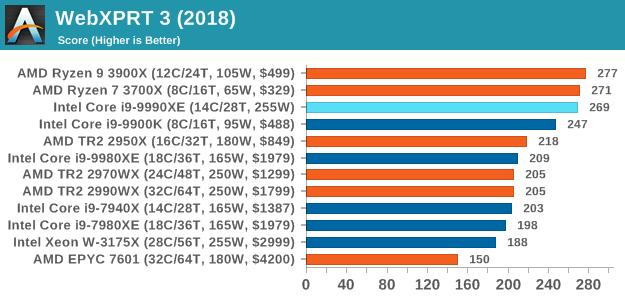
WebXPRT 2015: HTML5 and Javascript Web UX Testing
The older version of WebXPRT is the 2015 edition, which focuses on a slightly different set of web technologies and frameworks that are in use today. This is still a relevant test, especially for users interacting with not-the-latest web applications in the market, of which there are a lot. Web framework development is often very quick but with high turnover, meaning that frameworks are quickly developed, built-upon, used, and then developers move on to the next, and adjusting an application to a new framework is a difficult arduous task, especially with rapid development cycles. This leaves a lot of applications as ‘fixed-in-time’, and relevant to user experience for many years.
Similar to WebXPRT3, the main benchmark is a sectional run repeated seven times, with a final score. We repeat the whole thing four times, and average those final scores.
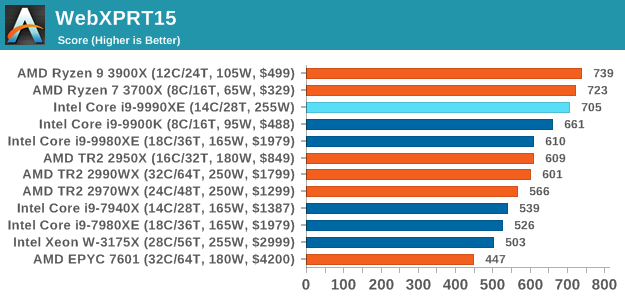
Speedometer 2: JavaScript Frameworks
Our newest web test is Speedometer 2, which is a accrued test over a series of javascript frameworks to do three simple things: built a list, enable each item in the list, and remove the list. All the frameworks implement the same visual cues, but obviously apply them from different coding angles.
Our test goes through the list of frameworks, and produces a final score indicative of ‘rpm’, one of the benchmarks internal metrics. We report this final score.
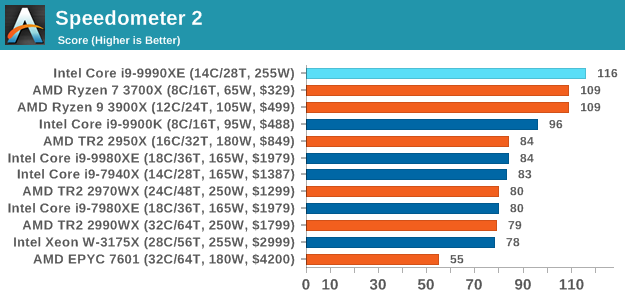
Google Octane 2.0: Core Web Compute
A popular web test for several years, but now no longer being updated, is Octane, developed by Google. Version 2.0 of the test performs the best part of two-dozen compute related tasks, such as regular expressions, cryptography, ray tracing, emulation, and Navier-Stokes physics calculations.
The test gives each sub-test a score and produces a geometric mean of the set as a final result. We run the full benchmark four times, and average the final results.
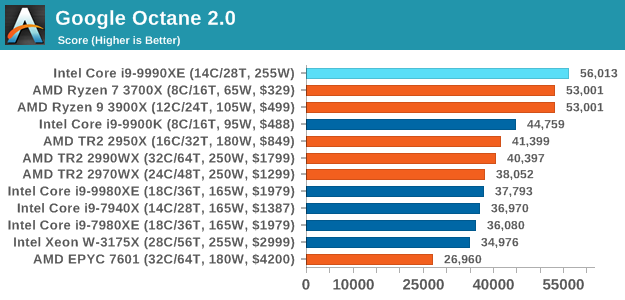
Mozilla Kraken 1.1: Core Web Compute
Even older than Octane is Kraken, this time developed by Mozilla. This is an older test that does similar computational mechanics, such as audio processing or image filtering. Kraken seems to produce a highly variable result depending on the browser version, as it is a test that is keenly optimized for.
The main benchmark runs through each of the sub-tests ten times and produces an average time to completion for each loop, given in milliseconds. We run the full benchmark four times and take an average of the time taken.
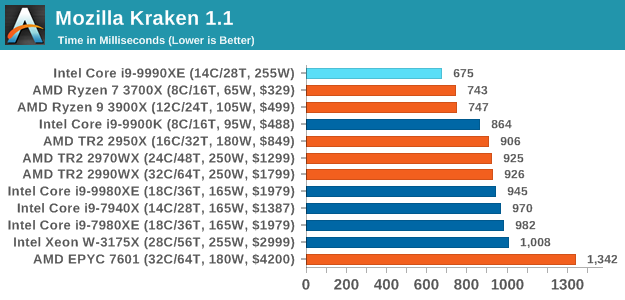
3DPM v1: Naïve Code Variant of 3DPM v2.1
The first legacy test in the suite is the first version of our 3DPM benchmark. This is the ultimate naïve version of the code, as if it was written by scientist with no knowledge of how computer hardware, compilers, or optimization works (which in fact, it was at the start). This represents a large body of scientific simulation out in the wild, where getting the answer is more important than it being fast (getting a result in 4 days is acceptable if it’s correct, rather than sending someone away for a year to learn to code and getting the result in 5 minutes).
In this version, the only real optimization was in the compiler flags (-O2, -fp:fast), compiling it in release mode, and enabling OpenMP in the main compute loops. The loops were not configured for function size, and one of the key slowdowns is false sharing in the cache. It also has long dependency chains based on the random number generation, which leads to relatively poor performance on specific compute microarchitectures.
3DPM v1 can be downloaded with our 3DPM v2 code here: 3DPMv2.1.rar (13.0 MB)
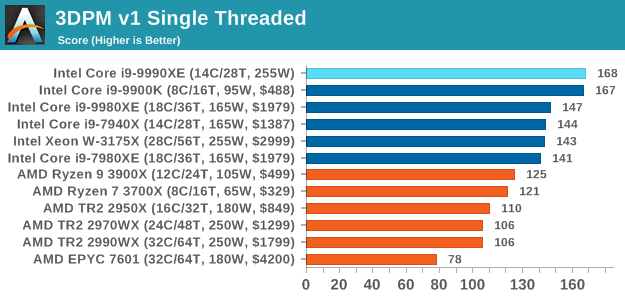
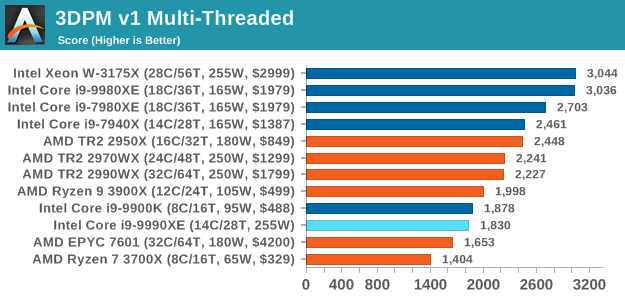
x264 HD 3.0: Older Transcode Test
This transcoding test is super old, and was used by Anand back in the day of Pentium 4 and Athlon II processors. Here a standardized 720p video is transcoded with a two-pass conversion, with the benchmark showing the frames-per-second of each pass. This benchmark is single-threaded, and between some micro-architectures we seem to actually hit an instructions-per-clock wall.
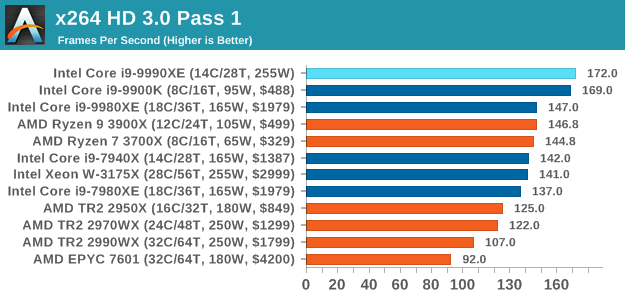
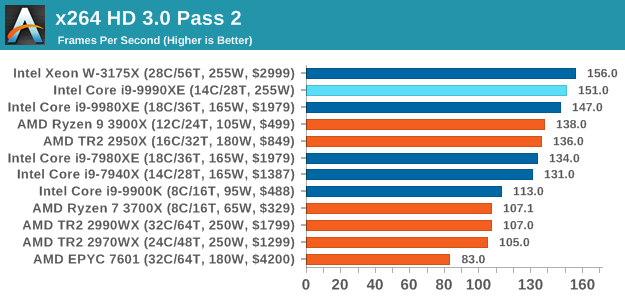










145 Comments
View All Comments
Supercell99 - Monday, October 28, 2019 - link
The democrats have banned LN2 in New York as they have deemed it a climate pollutant.xrror - Monday, October 28, 2019 - link
No they haven't you republican jackass, the Earth's atmosphere is 78% nitrogen.eek2121 - Monday, October 28, 2019 - link
Because after a while, the system breaks down under LN2 cooling. There is such a thing as silicon being too cold, you know. Google intel cold bug, for example.ravyne - Monday, October 28, 2019 - link
Have you seen LN2 cooling? It's not really practical for prolonged use -- you have to keep the LN2 flowing, you have to vent the gasses of the expended LN2, you have to resupply the LN2 somehow.But you're missing the most important constraint of all for high-frequency trading, which is the reason they're building this processor into just 1 rack unit -- these machines aren't running on some remote data center, they're running in a network closet or very small data center probably just a floor or two away from a major stock exchange, in the same building. There is only so much space to be had. The space that's available is generally auctioned and can run well into 5-figures per month for a single rack unit. That's why they're building the exotic 1U liquid cooling in the first place, it'd be much easier to cool in even 2 units (there's even off-the-shelf radiators, then).
edzieba - Thursday, October 31, 2019 - link
These machines are installed in exchange-owned and managed datacentres. "No LN2" as a rule would scupper that concept from the start, but even if it were allowed then you still have the problem of daily shipments of LN2 into a metropolitan centre, failover if a delivery is missed, dealing with large volumes of N2 gas generated in a city centre, etc. Just a logistical nightmare in general.eek2121 - Monday, October 28, 2019 - link
It's impossible to cool a system 24/7 with LN2.DixonSoftwareSolutions - Tuesday, October 29, 2019 - link
I think you probably could do something like that. You would want to run it on a beta system in parallel with your production system for a long time to make sure you had the 99.999999% uptime required. You would have to get pretty down and dirty to make it a 24/7 system. Probably a closed loop LN2 system, and I don't even know what kind of machine is required to condense from gas to liquid. You would also probably want heaters on the other components of the motherboard so that only the die was kept at the target low temp, and other components at the correct operating temp. And you would probably have to submerge the entire thing in some dielectric fluid like mineral oil to prevent condensation from building up. It would be expensive no doubt, but if (m/b)illions are on the line, then why not? Also, before embarking on something like this, you would want to make certain that you had tweaked every last bit of your software, both third party software settings and internally authored code, to minimize latency.willis936 - Monday, October 28, 2019 - link
Judging from your description I would argue that a traditional PC is a horrible choice for such a problem, given the money at stake. They should be spinning custom ASICs that have the network stack and logic all put together. Even going through a NIC across a PCIe bus and into main memory and back out again is burning thousands of nanoseconds.29a - Monday, October 28, 2019 - link
I'm also wondering why they don't create custom silicon for this.gsvelto - Monday, October 28, 2019 - link
They do, not all HFT trading houses use software running on COTS hardware. Depending on where you go you can find FPGAs and even ASICs. However, not all of them have the expertise to move to hardware solutions; many are tied to their internal sofware and as such they will invest in the fastest COTS hardware money can buy.